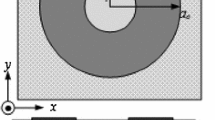Abstract
In this communication, a microstrip line fed dielectric resonator antenna is optimized using various Machine learning-based models. Different ML algorithms such as ANN (artificial neural network), KNN (K-Nearest Neighbors), XG Boost (extreme gradient boosting), Random Forest, and Decision Tree are used to optimize the proposed antenna design within the frequency band 3.3–3.65 GHz. |S11| of the proposed antenna is predicted by using various ML algorithms. Dataset for the same is created through HFSS EM (Electromagnetic) simulator by varying the radius, height of DRA (Dielectric Resonator Antenna) as well as the width of microstrip line and conformal strip. Predicted results from all these models are quite close to the actual one except ANN. To overcome the problem of ANN, Knowledge-Based Neural Network techniques (KBNN) are implemented. All these ML algorithms are authenticated by practically constructing and measuring the proposed antenna. Fabricated antenna results are in good agreement with the values predicted by ML algorithms.











Similar content being viewed by others
References
Tang T, Hong T and Liu C 2019 Design of 5G Dual-Antenna Passive Repeater Based On Machine Learning. In: 15th International Wireless Communications & Mobile Computing Conference (IWCMC), 2019, https://doi.org/10.1109/IWCMC.2019.8766614
Misilmani H E, Naous T and Khatib S A 2020 A Review on the Design and Optimization of Antennas Using Machine Learning Algorithms and Techniques. International Journal of RF and Microwave Computer-Aided Engineering 30: 1–7.
Gao J, Tian Y and Chen X 2020 Antenna Optimization Based on Co-Training Algorithm of Gaussian Process and Support Vector Machine. IEEE Access 8: 211380–211390.
Dadashzadeh G, Kargar M, Torabi Y and Rahmati B 2016 Broad-band and wide scan phased array element design using data mining. Appl. Comput. Electromagn. Soc. J. 31: 244–251.
Lee K C and Lin T N 2005 Application of neural networks to analyses of nonlinearly loaded antenna arrays including mutual coupling effects. IEEE Trans. Antennas Propag. 53: 1126–1132.
Sharma Y, Zhang H H and Xin H 2020 Machine Learning Techniques for Optimizing Design of Double T-shaped Monopole Antenna. IEEE Transactions On Antennas and Propagation 68: 5658–5663.
Jacobs J B 2015 Efficient resonant frequency modeling for dual-band microstrip antennas by gaussian process regression. IEEE Antennas Wirel. Propag. Lett. 14: 337–341.
Sharma K and Pandey G P 2021 Efficient modelling of compact microstrip antenna using machine learning. AEU-International Journal of Electronics and Communication 135: 1–10.
Russell S J and Norvig P 2016 Artificial Intelligence: A Modern Approach. 3rd Edition. Pearson Education, 2016
Watson P and Gupta K C 1996 EM-ANN models for via interconnects in microstrip circuits. IEEE MTT-S Int. Microwave Symp. Dig., 1819-1822
Deen Z, Ibrahim I I, Ibrahem S M M and Hassan A S 2006 Neural network-based CAD model for the design of hemispherical dielectric resonator antenna with a concentric conductor. In: Proceedings of the Twenty Third National Radio Science Conference (NRSC'2006) 1-7
Kajfez D, Glisson A W and James J 1984 Computed Modal Field Distributions for Isolated Dielectric Resonators. IEEE Trans. Microw. Theory Tech. 32: 1609–1616.
Mongia R K and Bhartia P 1994 Dielectric resonator antennas—a review and general design relations for resonant frequency and bandwidth. Int. J. Microw. Millimeter-Wave Comput. Eng. 4: 230–247.
Stutzman W L and Thiele G A 1998 Antenna Theory and Design. 2nd edn. Wiley, Hoboken, NJ, USA.
Author information
Authors and Affiliations
Corresponding author
Rights and permissions
About this article
Cite this article
Singh, O., Bharamagoudra, M.R., Gupta, H. et al. Microstrip line fed dielectric resonator antenna optimization using machine learning algorithms. Sādhanā 47, 226 (2022). https://doi.org/10.1007/s12046-022-01989-x
Received:
Revised:
Accepted:
Published:
DOI: https://doi.org/10.1007/s12046-022-01989-x




